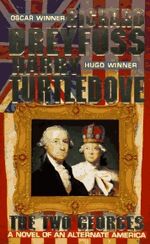| ||||||||||||||||||||||||||||||||||||||||||||||
Prince George, Duke of Kent (20 December 1902 - 25 August 1942) was a member of the British Royal Family. He was the fourth son and fifth child of King George V and Mary of Teck. In the late 1920s and early '30s, he often embarrassed the House of Windsor with his casual abuse of drugs and sex. He held the title of Duke of Kent from 1934 until his death in a military air crash during World War II, in 1942. This was the first death of a Royal Family member in active service since King Richard III in 1485.
He was the younger brother of Kings Edward VIII and George VI (formerly Albert, Duke of York) and the uncle of Queen Elizabeth II.
George, Duke of Kent in The Two Georges[]
George, Duke of Kent was the younger brother of King-Emperor Edward VIII, who reigned in the mid 20th century. In 1994, Titus Hackett and his business partner Franklin Mansfield were charged with printing and distributing an obscene publication, which lampooned the marital problems of the Duke's grandchildren, in New Liverpool, North American Union. However, they were acquitted of these charges.[1]
Literary Comment[]
The authors may have confused George of Kent with his older brother Albert, Duke of York (later also called George), several of whose grandchildren had marital problems which were widely covered by tabloids in the OTL 1990s. On the other hand, it may be an indirect reference to Kent's own youthful activities. There is no internal inconsistency.
References[]
- ↑ The Two Georges, pg. 86, MPB.
| |||||||||||||||||||||||||

